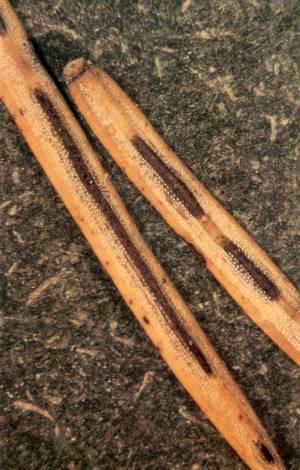Spruce Needle Cast

United States Department of Agriculture
Prepared by
Forest Service Alaska Region
Leaflet
R10-TP-12
SPRUCE NEEDLE CAST
Spruce needle cast caused by the fungus Lirula macrospora is a common disease of spruce trees in coastal areas of Alaska. It affects Sitka spruce from southeast Alaska to Kodiak Island and the Alaska Peninsula. The disease most commonly infects small trees, but also affects the lower crown of large trees.
Heavily infected Sitka spruce appear discolored (Figure 1) because of dead and dying needles in the crown. Infected needles turn reddish-brown when they are one year old (Cover photo), and tan when two years old. Conspicuous fruiting bodies of the Lirula fungus mature on the tan two-year-old needles (Figures 2 and 3). This leaflet briefly describes the biology of spruce needle cast and provides information to help homeowners and foresters recognize and control this disease.
IDENTIFICATION AND LIFE HISTORY
Spruce needle cast is easy to identify due to the characteristic, elongated black fruiting body of the fungus and because different symptoms develop on needles of different ages.
The disease should not be confused with discolored needles that lack long, black fruiting bodies (e.g., caused by spruce needle aphid) or with another fungus, Lophodermium picea. This latter fungus has shorter, elliptical black fruiting bodies and is more common on dead needles of white spruce in interior Alaska.
Microscopic spores of the Lirula fungus are released from the fruiting bodies during cool, moist weather in spring, when spruce needles emerge from buds. The spores are spread by splashing water or air currents to the new, succulent, bright-green needles. A sticky outerlayer on the spores enables them to adhere to the needles. The spores then germinate and start to colonize tissues inside the new needles. Older needles are resistant to infection because they have waxy outer layers.
Even though the fungus grows inside the young needles, the needles remain green until they are one year old and then turn reddish-brown. Because of this delay in symptom, it may appear as though only older needles are infected.
Immature black fruiting bodies begin to appear on infected one-year-old needles by late summer and develop until the next spring, when they split open to release the spores. Thus, spores are released from fruiting bodies two years after needles are infected.
During any summer, one spruce branch may have all of these stages: young, green needles that were infected in spring; reddish-brown one-year-old needles with immature black fruiting bodies; and tan two-year-old needles with mature black fruiting bodies that have released their spores (Figure 4). Once fruiting bodies are empty, dead needles may begin to fall away; some dead needles are retained for several years.

Figure 1. Trees infected with spruce needle cast may appear unsightly even though new needles remain green for one year.

Figure 2. The black, elongated fruiting body of the Lirula fungus appears on the underside of tan two-year-old needles.

Figure 3. Close-up view of the fruiting body of the Lirula fungus.

Figure 4. Symptoms can help identify spruce needle cast; new needles (emerging from buds) are green; when infected, one-year-old needles are reddish-brown and two-year-old needles are tan.
DAMAGE
Spruce trees are not normally killed by needle cast. Infected needles are often concentrated in the lower crown, the portion of the crown that contributes least to growth and vigor.
Heavily infected spruce trees appear unsightly due to the numerous dead and dying needles, and may be a concern to homeowners.
In some forests the disease appears only sporadically. Most new needles on small trees may be infected during one year, but the disease may be uncommon the next year. In other areas, however, the disease can be serious every year. Spruce trees that are heavily infected year after year probably grow more slowly than uninfected trees, or may be easily damaged by other diseases, insects, or environmental stresses.
GUIDELINES FOR REDUCING DAMAGE
Because the damage caused by spruce needle cast is usually cosmetic, homeowners may not need to take action to control it. However, three approaches are available to homeowners wishing to minimize the unsightly appearance and slowed growth of heavily infected trees:
- Infection levels can be decreased by modifying local atmospheric conditions around spruce trees. Moist, stagnant air favors development of the Lirula fungus. Thus, pruning some branches of trees with dense crowns or removing closely adjacent trees or shrubs can increase air movement and reduce infection levels.
- Chemical control using fungicides can protect trees, but only if application coincides with sporulation of the fungus in spring. Fungicides could be applied shortly after new needles emerge (at about the stage of Figure 4) and/or just before shoots are fully elongated (at about the stage of the cover photo). Once shoots are fully elongated and needles are stiff and darker green, many needles are probably infected and fungicide application is too late. Contact the Cooperative Extension Service for recommended fungicides.
- Plant trees other than spruce. All other trees are immune to the disease.
Foresters can reduce damage in areas that historically have a high incidence of Lirula by increasing spacing distances between trees or leaving more hemlock, which is immune to the fungus, interspersed with spruce during thinning operations.
Spruce Needle Cast, by Paul E. Hennon, Forest Pathologist, USDA Forest Service, Alaska Region, State and Private Forestry.
For more information, contact Robin Mulvey, Forest Pathologist, USDA Forest Service, Alaska Region, State and Private Forestry; contact details: rlmulvey@fs.fed.us, 907-586-7971.
CAUTION: Pesticides can be injurious to humans, domestic animals, desirable plants, and fish or other wildlife-if they are not handled or applied properly. Use all pesticides selectively and carefully. Follow recommended practices for disposal of surplus pesticides and pesticide containers. Mention of a pesticide in this publication does not constitute a recommendation for use by the USDA, nor does it imply registration of a product under the Federal Insecticide, Fungicide, and Rodenticide Act, as amended. Mention of a proprietary product does not constitute an endorsement by the USDA.

